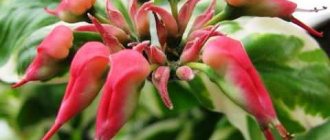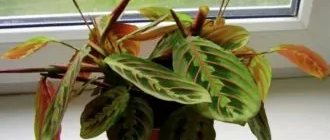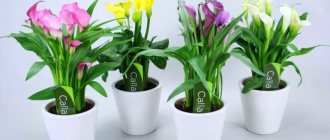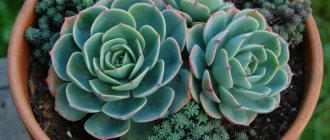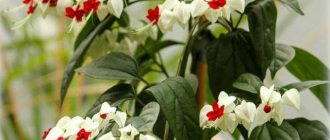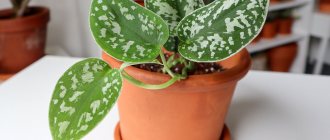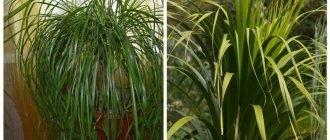Scindapsus or epiprenium (Epipremnum) is a herbaceous semi-epiphytic perennial of the Araceae family, the shoots of which in their natural habitat spread along the ground or climb along the bark of trees and reach a length of 40 meters.
When grown indoors, the size of the plant is more modest - only about 4.5 meters in length. The homeland of scindapsus is Southeast Asia. The main decoration of the plant is lush emerald greenery: the leaves of scindapsus are large, leathery, heart-shaped, and in some varieties they are covered with a marble pattern of various shades of white and yellow. The scindapsus flower is not particularly remarkable; it is a small spadix wrapped in a “veil” of a greenish-whitish hue.
Also see how to grow indoor Homalomena and Monstera.
| They have a high development rate - they add up to 45 cm per year. |
| Does not bloom indoors. |
| The plant is easy to grow indoors. |
| Perennial. |
Useful properties of scindapsus
Scindapsus aureus.
Photo of Scindapsus painted. Photo Scindapsus perfectly filters the air in the room where it is located, absorbing most harmful impurities (even toxic compounds of formaldehyde and benzene). Eastern teachings also attribute to the plant the ability to accumulate and redistribute vital energy in the right way, to have a beneficial effect on a person’s mental and physical health, and to maintain the good spirits and optimism of its owner.
Features of scindapsus and its difference from other vines
The plant comes from the humid tropics of Southeast Asia. Scindapsus in nature is a liana up to 15 m long. Many species that were previously included in the genus Scindapsus are assigned to the genus Epipremnum in the new botanical classification. In the literature on indoor floriculture, these names are used as synonyms. Scindapsus and Epipremnum belong to the same family Araceae. Looking at the photo, it is difficult to determine which flower is in the frame.
Externally, these plants are very similar. Although experts notice the slightest characteristic generic signs. Changing the botanical affiliation does not affect care, since the requirements of the crops for growing conditions are the same.
Differences between scindapsus and epipremnum:
- In Scindapsus species there is only one ovary in the ovule, in Epipremnum there are several, therefore the fruit of Scindapsus contains fewer seeds than in Epipremnum. (Both plants do not bloom indoors or outdoors in our climate).
- Scindapsus forms creeping or climbing thin, rarely branching shoots. The length of the stem in indoor conditions reaches an average of 1 m. The leaf blades are heart-shaped with smooth edges and grow alternately.
- The leaves of Scindapsus pictus are leatherier than Epipremnum and are covered with many tiny dots that sparkle like pearls in the light. They create subtle green and silvery-white spots.
Macro photograph of a scindapsus leaf
Scindapsus are different from indoor philodendrons. The leaf shape of Philodendron scandens is more heart-shaped than those of Scindapsus aureus and Scindapsus pictus. The leaf blades of philodendrons are 20 cm long, later much larger, at first they have a bronze color, becoming dark green over time. Scindapsus leaves are ovoid, 10–15 cm in length. Several thin aerial roots develop in the nodes on the shoots of philodendron; in scindapsus, one dense, brown root develops in one node. Other differences in appearance of non-flowering vines are not visible.
Scindapsus also differs from another popular vine - syngonium. They have different shapes and sizes of leaf blades. In representatives of the genus Syngonium it varies depending on age. The leaves of young syngonium are arrow-shaped, with a bright marble pattern. As the leaf blades grow, they take on a shape with well-defined lobes, which is not typical for scindapsus. At the break of syngonium shoots, milky juice is released.
Interesting signs and legends are associated with climbing plants. Residents of Ancient Greece believed that scindapsus or epipremnum in the house brought good luck and money to the owner of the home. An indoor flower with such an “aura” is a good gift for a housewarming or birthday.
Scindapsus: care at home. Briefly
| Temperature | Room temperature in summer (+18-+24°C), low temperature in winter (+13-+16°C). |
| Air humidity | Increased, requires regular spraying. |
| Lighting | Moderate diffused, partial shade is suitable. |
| Watering | Moderate with short periods of soil drying to approximately 2/3 depth. |
| Soil for scindapsus | Any loose nutritious soil. The plant is well suited to a mixture of garden soil, peat and sand, taken in equal proportions. |
| Feeding and fertilizer | From spring to autumn, once every 2-3 weeks, apply liquid fertilizer for indoor plants. |
| Transplantation of scindapsus | Annually for young plants, once every 2-3 years for mature, well-developed bushes. |
| Reproduction | By seeds, cuttings or air layering. |
| Features of cultivation | Scindapsus can be grown at home on a support - a long pole covered with moss. To maintain a neat shape and decorative appearance, it is recommended to regularly subject the plant to formative pruning. |
Botanical description
Under natural conditions, scindapsus is a powerful semi-epiphytic liana that wraps around tree trunks and climbs them to a height of 15 meters. Like its relative Monstera, scindapsus has not only underground fibrous roots, but also aerial ones, which help it climb to a decent height and spread for kilometers. In Florida and Sri Lanka, scindapsus occupies such vast areas that it has to be dealt with as a dangerous parasite that disrupts the ecology in the region.
- Photo of agapanthus flowering
At home, scindapsus is a climbing plant with attractive bright green or variegated leaves, similar to the leaves of some types of philodendron - simple, oval, leathery and shiny, alternately located on the stem. Scindapsus blooms, like all representatives of the Araceae, with a small inflorescence similar to an ear of corn, wrapped in stipules like a blanket. Unfortunately, the indoor scindapsus flower almost never blooms, but it has such a remarkable advantage as its unpretentiousness in maintenance.
Scindapsus: care at home. Details
Bloom
The scindapus plant blooms extremely rarely at home. In the natural habitat, small, inconspicuous flowers-cobs regularly appear from the axils of the shoots, wrapped in “spreads” of whitish or greenish shades.
Temperature
During the period of active growth, it is recommended to keep scindapsus in a room with an air temperature of about +20°C; in winter, the plant requires moderate coolness - about +15°C.
Spraying
The plant is moisture-loving and does not tolerate dry air in city apartments, so it is recommended to spray it regularly: in the summer at least 3 times a week (preferably daily), in the winter - as needed.
In addition, it is useful to periodically wipe scindapsus leaves with a damp soft cloth to remove dirt and dust.
Lighting
At home, Scindapsus prefers moderate diffused lighting, so eastern or western windows are best suited for its maintenance. The plant can easily adapt to life in partial shade, but in this case the leaves become smaller and their color becomes less saturated.
Watering scindapsus
Water the plant regularly and moderately (once every 4-5 days in summer, once every 7-10 days in winter), avoiding stagnation of moisture in the soil. Water for irrigation is taken at room temperature; after watering, be sure to pour out excess liquid from the pan so as not to provoke rotting of the roots and infection of the plant with fungal diseases.
Pot for scindapsus
Scindapsus should be planted in a medium-sized container of shallow depth. The plant grows its root system quite quickly, but in a pot that is too spacious it does not feel particularly good, it can get sick and even die.
Another requirement for the pot is the presence of a drainage hole to remove excess moisture from the roots.
Priming
Light, moisture- and breathable soil is selected for the plant. Scindapsus can be grown in purchased soil intended for ornamental leafy plants, or in a self-prepared substrate of leaf and turf soil with the addition of peat and sand (all ingredients are taken in equal proportions).
Feeding and fertilizer
During the period of active growth, scindapsus is fed every 2-3 weeks with any liquid fertilizer for ornamental leaf plants. Feeding is temporarily stopped if at the end of autumn the flower goes into a dormant state.
In cases where scindapsus continues to grow without rest in winter, it is fed once a month during this period.
Transfer
Young plants develop very quickly, so they are replanted every year until they are 3 years old. Transplantation of scindapsus at a more mature age can be carried out less frequently - as the root system of the flower grows. For old specimens, it is enough to update the top layer of soil in the pot once every 2-3 years.
Trimming scindapsus
Without proper attention, the plant grows very strongly, and over time its shoots stretch out and lose their decorative properties, so caring for scindapsus at home must necessarily include regular formative pruning. It is carried out every spring, shortening all adult stems by about half their length.
Rest period
Homemade scindapsus does not have a clearly defined dormant period, but its most active growth occurs from early spring to mid-autumn. In other months, the plant slows down in development, so it is temporarily stopped feeding and watered very moderately, avoiding waterlogging of the soil, so as not to provoke the appearance of rot.
Scindapsus - can I keep it at home?
Popular rumor ranks scindapsus among the so-called “husband killers” - plants that expel a husband from the house. I don’t want to look cynical in the eyes of superstitious people, but what about families in which both the husband is at home and the scindapsus is on the wall? Don't you have such acquaintances? Maybe it’s not a matter of scindapsus after all? If your personal life depended on what flowers you grow for yourself, what color clothes you wear or what superstitions you believe in... However, if your belief in superstitions is so strong, do not grow scindapsus - after all, there are many other plants.
- Conditions for growing amaryllis
But Eastern sages discovered exactly the opposite properties of scindapsus: this plant absorbs stagnant energy and laziness, inspires creativity, softens the tension in the atmosphere in the house and helps to get out of a psychological impasse.
Growing scindapsus from seeds
It is problematic to obtain your own seeds from the plant, because it does not bloom under indoor growing conditions, so scindapsus is propagated using purchased seed material. Seeds are sown in pre-prepared light, loose soil and lightly sprinkled with soil.
In a greenhouse under glass or film, the seeds germinate within several weeks. With the emergence of seedlings, the shelter is removed, and the container with the crops is taken to a well-lit place. After a few more weeks, the strengthened seedlings are planted into separate pots.
Plant propagation
Methods
By cuttings
- ¾ Cut the apical stalk with 2-3 leaves at an angle of forty-five degrees
- ¾ Place it in a weak solution of potassium permanganate for a short time to avoid rotting
- ¾ Place in water until roots appear
- ¾ For rooting, plant in a mixture of sand and moss
- ¾ Cover the top with a jar or plastic bag
- ¾ Place in a place with good lighting at a temperature of +22C
- ¾ After 2-3 weeks, transplant into the ground
- ¾ Keep under the adaptation bag. Ventilate periodically
By layering
- ¾ Pin the shoot to the ground with a bracket
- ¾ After rooting, cut off cuttings from the mother plant
- ¾ Place in a favorable place
The main conditions for successful rooting are:
- The presence of 2-3 leaves on a stem or cuttings
- Air temperature +22C
- Good illumination
Diseases and pests
Scindapsus practically does not create problems for its owner during the growth process, but it reacts painfully to gross and systematic errors in care, which manifests itself in a deterioration in its appearance:
- Scindapsus leaves turn yellow when nutrients in the soil are depleted. The plant should be fed regularly during the active growing season.
- Brown spots on the leaves indicate low humidity in the room. The problem can be solved by regularly spraying the plant and periodically wiping its foliage with a damp soft cloth.
- The tips of scindapsus leaves also curl due to the dry air in the room where the flower is located. Spraying helps increase humidity.
- Black edges of the leaves are a sign that the plant is “freezing” and is too wet. It is necessary to adjust the temperature and watering mode.
- Pale and small leaves of scindapsus appear in poor lighting; the plant loves bright, diffused light, so it is better to place the pot with it on bright eastern or western windows.
- The stem has stretched out - also a sign of a lack of light; the plant needs to be moved from the shadows to a more illuminated part of the room.
- The leaves of scindapsus turn pale under the influence of too bright sun, from the direct rays of which the plant must be shaded.
- Brown tips on scindapsus leaves usually appear if the flower is near a source of artificial heat. It is better not to place a pot with scindapsusosm near a radiator or heater, but if no other place can be found for it, the plant should be regularly wiped and sprayed.
There are few pests that pose a danger to scindapsus; these include mealybugs, spider mites, aphids and scale insects. Modern insecticides cope well with them.
Scindapsus - leaves turn yellow, what to do?
This can happen for various reasons. If the tips of the leaves of scindapsus turn yellow, this indicates a long lack of moisture, rare spraying under conditions of elevated air temperatures. If there is a heating device nearby, it is better to move the pot away from it. Withering foliage and loss of elasticity indicate a nutrient deficiency. It is necessary to feed the flower as quickly as possible and continue to do so regularly. Foliage may also fall due to drafts, which the plant does not like.
Types of scindapsus domestica with photos and names
Epipremnum pinnatum
A spectacular ampelous variety with very long flexible shoots and beautiful leathery heart-shaped leaves, painted in a lush green color with a golden marble pattern over the entire surface. When grown indoors, it blooms extremely rarely with an inconspicuous flower-cob surrounded by a narrow greenish “veil.”
Scindapsus aureum (Epipremnum aureum)
A widespread species in indoor floriculture with long stems and large glossy dark green leaves with a beautiful pattern of golden-yellow spots and stripes across the entire surface of the leaf blades.
Spotted or painted scindapsus (Scindapsus pictus)
A liana-like plant with long tenacious shoots and large, dense, ovoid, dark green leaves, the surface of which is covered with a pattern of wide silver-gray spots of irregular shape.
What types to grow at home
There are about 25 species in the wild. Florists use 6.
Scindapsus aureus
Shoots up to 2 meters. The leaves are bright, heart-shaped. They have yellow designs on them. Purifies the air in the room from benzene, carbon monoxide and other pollutants.
Scindapsus N-Joy
The flower is compact, bred in Holland. The leaves are bright yellow with silver dots. Gain popularity.
Scindapsus Marble Queen
The scindapsus plant is of amazing beauty. Leaves with unique touches. The second name is the Marble Queen.
Scindapsus Exotica
The hybrid was bred by breeders. The sides of the leaf blade are different, so the central vein is curved. When palpated, lumpy irregularities are felt.
Scindapsus Neon
The leaves are bright light green. It grows very quickly and requires timely pruning of shoots.
Scindapsus Pictus or Painted
Stretches up to a meter. The leaves are large, oval. Their length is 13-15 cm. Silver-gray. Almost never gets sick.
Indoor flowers scindapsus are classified as climbing ampelous plants. They are planted in plant pots, pots, flowerpots, baskets, or given the opportunity to spread out in vines in a given direction.
Possible problems during cultivation
The scindapsus flower is an unpretentious indoor plant, but gross mistakes in care can cause great harm to it.
- A clear sign of insufficient watering is dry leaf tips. To compensate for the damage to the health of the flower, start watering it more often and spray the leaves with water.
- Another common mistake in caring for scindapsus is over-irrigation. The leaves become soft and covered with brown spots. In this case, reduce watering.
- Yellow, limp leaves are a sign of the development of root rot. You need to remove the plant from the pot, carefully shake off the soil and inspect the roots. If you find rotten areas, cut them off and treat the cut areas with crushed charcoal or activated carbon. Plant the plant in fresh soil and water moderately.
- A sign of incorrect placement of scindapsus is small leaves, large distances between nodes, and faded coloring. Place the pot with the plant in a brighter place.
- The yellow color of the leaf blades indicates a lack of nutrients. Feed the flower with fertilizer containing microelements.
